MXA’S KTM 350SXF TECH TIPS & SETUP ADVICE
1. Shock spring. The stock 48 N/m shock spring is too stiff for anyone under 190 pounds. If you weigh less than 190 pounds you will not be able to get any preload on the shock spring. We run the 45 N/m shock spring from the 250SXF on our 350SXF. The shock needs to have preload on it—if you can’t get preload on the spring for your weight, then you need a lighter spring. KTM will change to the 45 N/m spring for 2017. We run the low-speed compression at 15 out, the high-speed at 1-3/4 turns out and the rebound on 10. When we have issues, we start with the high-speed adjuster first and then move to the low-speed clicker.
2. Race sag. We run 105mm of sag. KTM recommends 110mm of sag, but this is way too much and not only eats up shock shaft travel, but kicks the head angle out so much that you have to slide the forks up very high in the clamps to get the bike to turn.
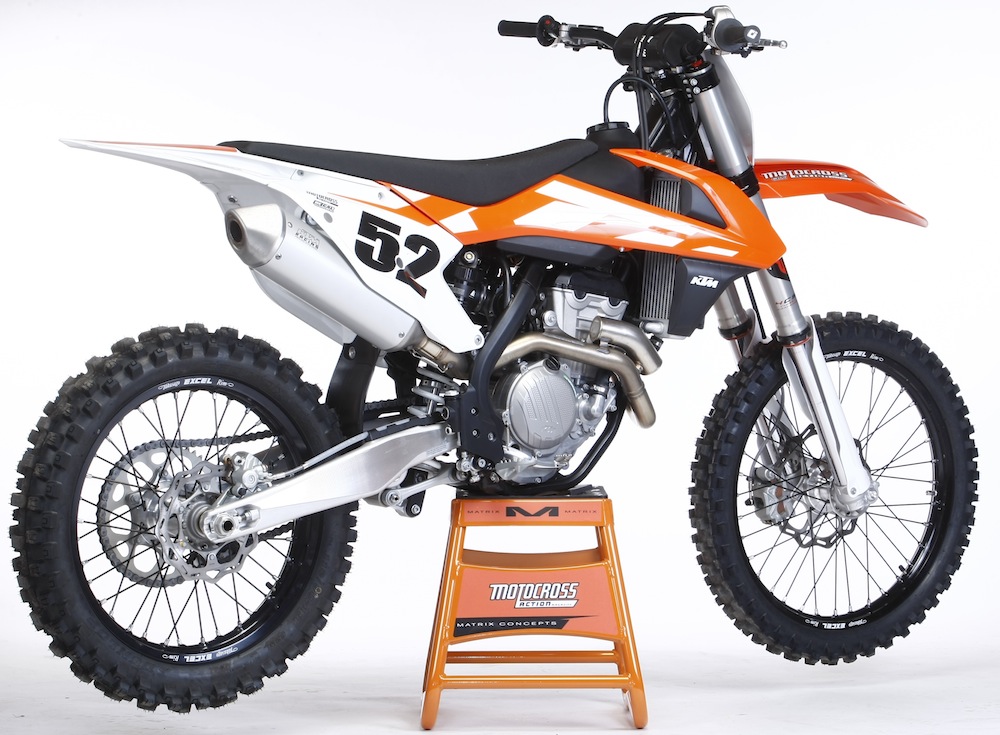
3. Peak power. The KTM 350SXF makes makes 54.41 horsepower, which is more than a CRF450 makes, but it makes its peak horsepower at 13,400 rpm. That means that if you shift before peak, you will get less horsepower. Thus, you should never shift. To help with this high-rpm necessity, we run a 51-tooth sprocket. It tightens up the ratios and helps get to 13,400 rpm quicker. We repeat—do not shift.
4. Sprocket bolts. Watch the sprocket bolts. They come loose all the time.
5. Tubes. The stock tubes are very thin and light Pirelli tubes. You will get flat tires with these tubes.
6. Neutral. Neutral is hard to find when the engine is running, but that is so that you can’t accidentally hit it on the track. Once you shut the engine off the tranny can easily be put into neutral.
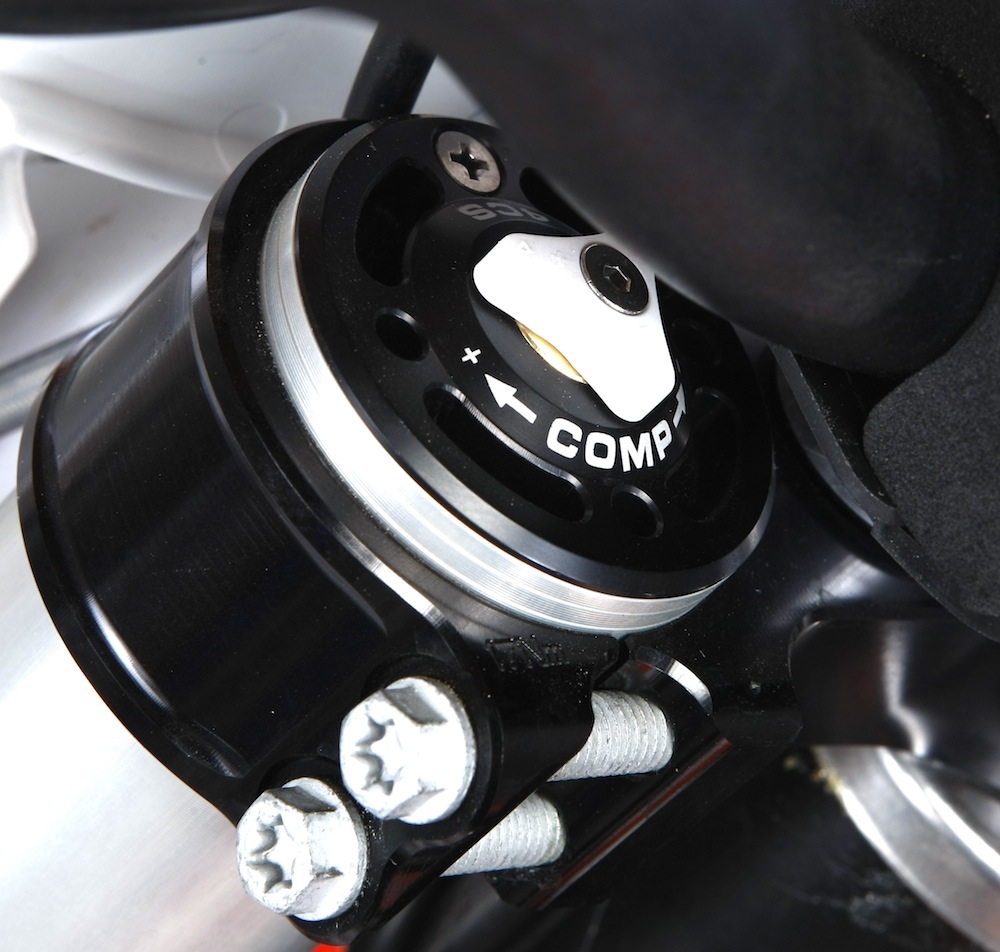
7. WP forks. The 2016 forks have been replaced with much better performing WP AER forks in 2017. As for last year’s 4CS forks, we’ve had Pros run them at 1 click out on compression, 6 clicks out and when Mike Alessi rode our bike he turned them to 11 clicks out. Slower riders will be happier in the 16 to 20 click range. These are not the greatest forks on the showroom floor, and are best suited to Novices and Vets. Fast Intemediates and Pros will hate them. We suggest sending them to your favorite suspension tuner—as for us, we run WP Cone valves forks on our 2016 350SXF—this is WP’s version of A-Kit forks. They cost $3400.
8. Exhaust pipe. To remove the exhaust pipe you have to remove the rear shock. There is a trick to doing this. We swing the shock linkage rearward (note the position in the photo above), drop the shock down below the swingarm, turn the shock clockwise and then pull it out through the rubber mud flap. It helps to have a friend raise and lower the swingarm as you do this—plus, it takes some muscle.. Aftermarket pipes don’t need to have the shock removed.
9. Battery. In cold weather you should pre-heat the Iron Phosphate (LiFeP04) battery before trying to start the bike. We touch the starter button enough to activate the starter, but not enough to get the bike to turn over. When you do this you can hear the starter clicking over (or feel it with your hand on the gas tank). We do this two or three times. Why? Because Iron Phosphate batteries get stronger as they get warmer. Then, once we have the battery preheated we push the choke up (not down) and start the bike.
10. Shift lever. We broke two shift lever tip springs when we first started testing 2016 models. The spring that makes the tip flip in and out snaps. When this happens at the track, we wrap duct tape around the tip to keep it in position so we can race. Because the tip is riveted on, there is no simple way to replace the spring. After we complained, KTM told us that they were installing a better spring and true to their word—we didn’t break any more shifter tips.
11. Spokes. The rear spokes will come loose for a very long time. It takes them quite a while to seat. Always watch the spokes next to the rim lock. If they are loose, then the rest of the spokes are on there way. We check the spokes at every race (and sometimes between motos).
12. 2016 Maps. There is a switch on the right side of the handlebars that allows you to choose between the stock map and aggressive map or mellow map. We always run the aggressive map. When the switch is in the forward position the bike will always be on the stock map. When the switch is moved rearward to the two dash marks, it will be in whatever map you select on the map selector dial in the airbox. In the upper right hand corner of the airbox is an rubber-covered dial. Pull the rubber cover back and you will see a dial with ten numbers on it. Whatever number you choose on this dial, will be the map on the rearward switch position. But, there is a trick. Map #1 is the mellow map, map #2 is the aggressive map and maps #3, 4, 5, 6, 7, 8, 9, 0 are all stock maps. If you choose 3, 4, 5, 6, 7,8, 9 ,0 then both switch positions will be stock maps. We put the dial on #2 (you have to look closely to see the white triangle on the side of the dial that indicates what number you are on).
13. 2017 Maps. The 2017 has a multi-switch on the left handle bar that allows you to choose between two maps (without having to go into the airbox to change any dials). Plus, the multi-switch accesses launch control and traction control
13. 2016 Launch control. The 2016 KTMs have launch control. You activate it by flicking the map selector switch back and forth. When launch control is engage the EFI light, behind the front number plate, will flash rapidly. Be forewarned. Launch control will only stay engaged for three minutes or until you rev the engine and then let the rpm fall off 30 percent or more. What does that mean? If you engage launch control on the starting line and then blip the throttle or do a burn-out, you will no longer be in launch control. And, you have to turn the bike off to re-engage launch control. The best strategy is to wait until just before the board turns sideways, then flick the switch to activate launch control. Once you begin to rev the engine up be careful not to let the rpm fall off. If you do, you will revert back to whatever map you chose. It is very tricky to hold steady rpm in the rush of the start process.Laucnh control for the 2017 350SXF is on the multi-switch. You engaghe it by prressing the map button and Traction Control button at the same time. It is subject to the same limitations as the 2016 version.
14. Fuel filter. KTM installs inline fuel filters in their gas lines. They can be accessed via the quick release fitting on the fuel line. You can flick the small nylon filter out and check it for debris. They can be back flushed or replaced. Clogged filters hurt the fuel pressure and flow. Be very careful to make sure that the fuel line clicks back together completely. We have had the quick release pop off because we didn’t get it clicked. When the fuel line pops off, the engine stops almost immediately. Click it!
15. Shock preload adjustment. When we need to adjust the preload on the rear shock, we do not hit the red shock collar with a hammer. Instead, we turn the shock spring by hand while using a long flat-bladed screwdriver to pry against the frame and the shock collar at the same time. If you hit the nylon shock collar with a hammer and punch, you will deform the notches.
16. Rear brake pedal spring. Turn your rear brake pedal spring around so that the tang on the spring closest to your foot faces inward. If it faces outward, you can hit it with your boot and unhook the spring. We also crimp the tangs once they are turned around to make them fit tight to the pedal. If your brake pedal spring looks like the one above—turn it around
17. Gas cap. The gas cap sticks. Be careful not to torque it on too tight because sometimes it takes Mr. Universe to get it off.
18. Ignition cover plug. The small Allen plug on the back of the 250SXF and 350SXF ignition covers can leak oil (although not enough to create any major issues, but it does make a mess). This plug can be sealed with high-temp silicone. The Allen plug doesn’t attach to anything, it is just there to block a hole that was drilled in the case during manufacturing to make an internal oil line make a 90-degree bend.
19. Dunlop MX3S tires. The MXA wrecking crew loves the MX3S (previously called MX32) tires that come stock on the 2016 KTMs—especially the front in comparison to the MX52 that come as OEM equipment on many 2016 bikes. But, be forewarned, if you push the MX3S front out of its intermediate terrain, you will begin to lose side knobs on the front tire. Oh, don’t get us wong it works well on hard terrain, but not for long. These are race-quality premium tires—and when used on the wrong terrain they will wear prematurely.
20. KTM footpeg springs. Many riders have broken KTM footpegs spring this year, but it is not the fault of the footpeg springs. Many KTM dealers have been installing the new springs the old way. And, when they do that, the new springs break. MXA went through the pits at Glen Helen and looked at several 2016 KTMs and half of them had the footpeg springs installed wrong at the dealer level. To check your footpeg springs, peel back the plastic frame guard and look at where the footpeg spring hooks to the frame. If it is anywhere other than where it is shown in the above photo—it is wrong.
21. dyno daze. The 2016 KTM 350SXF romps on the dyno. How else can you describe a 350cc engine that produces 54.41 horsepower? That is more horsepower than some 450cc motocross bikes make. At 7000 rpm, the 2016 model makes 37 horses (in 2015 it made 35.77). At 8000 rpm, it makes 44.42 (last year it made 42.08). At 9000 rpm, it makes 49.47 (last year it made 47.74). At 10,000 rpm, it makes 50.88 (last year it made 49.37). At 11,000 rpm, it makes 53.49 (last year it made 51.93). At 12,000 rpm, it makes 53.80 (last year it made 52), and at 13,000 rpm, it makes 54.08 (last year it made 52). Peak horsepower is 54.41 at 13,400 rpm.


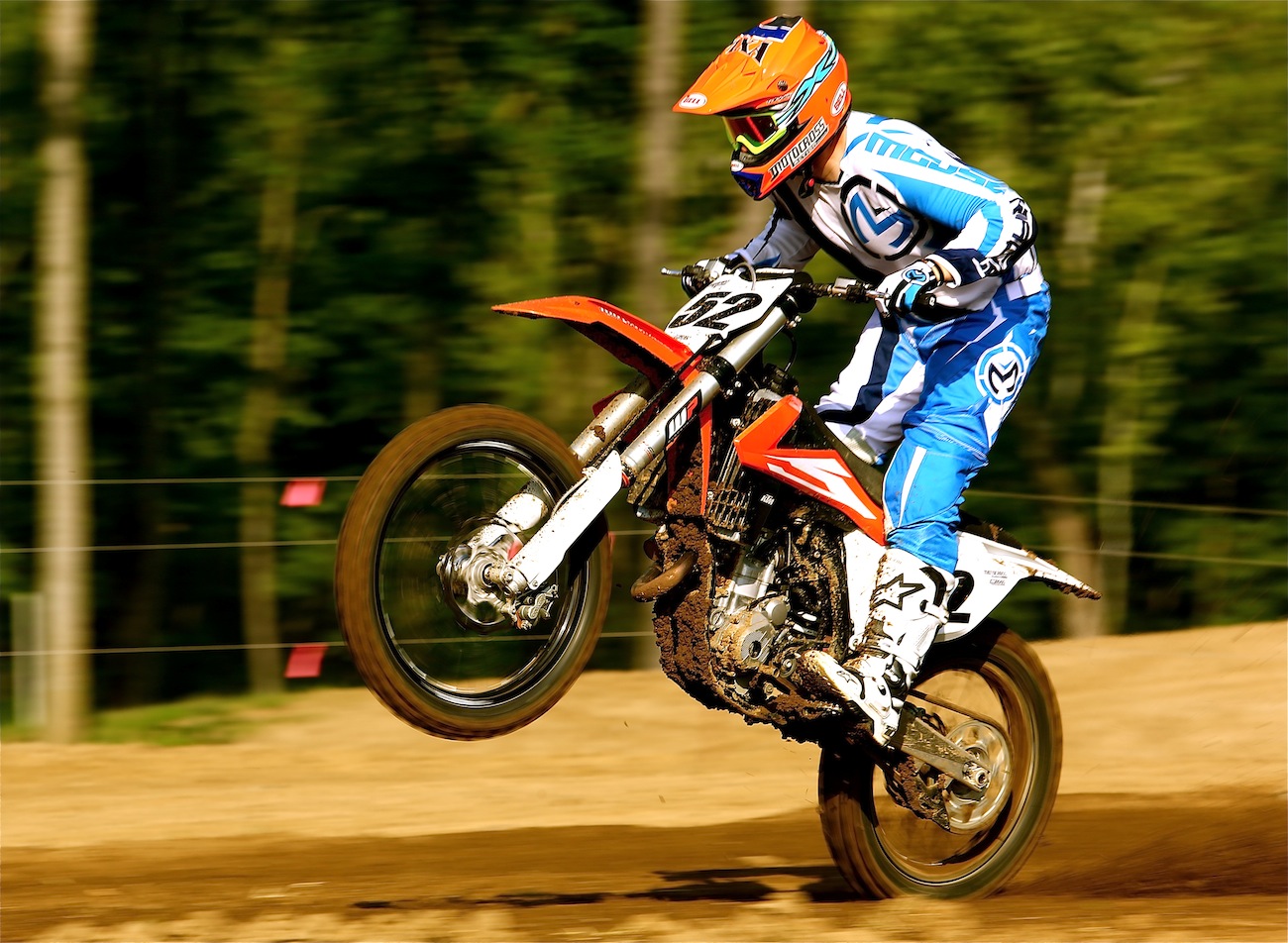

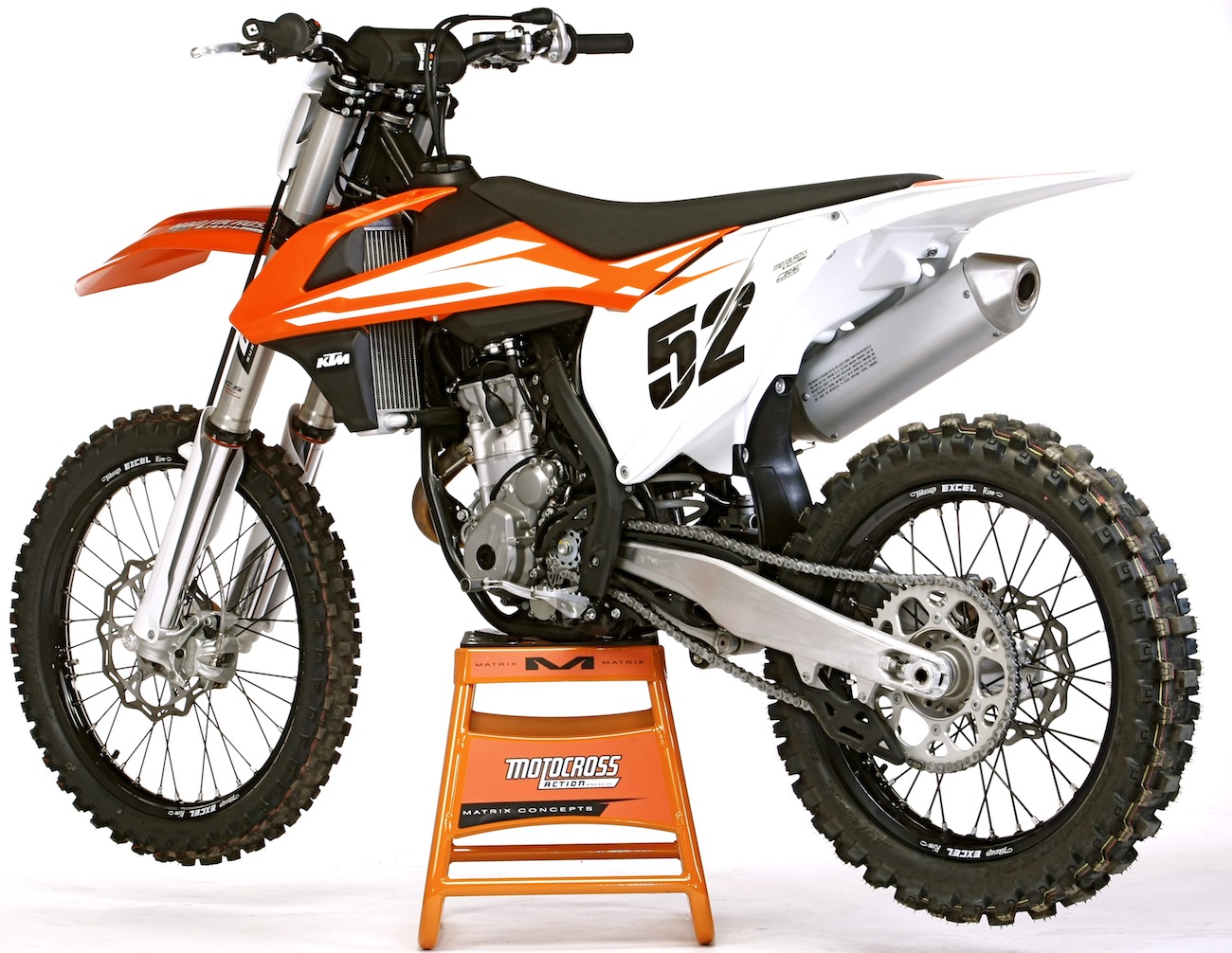
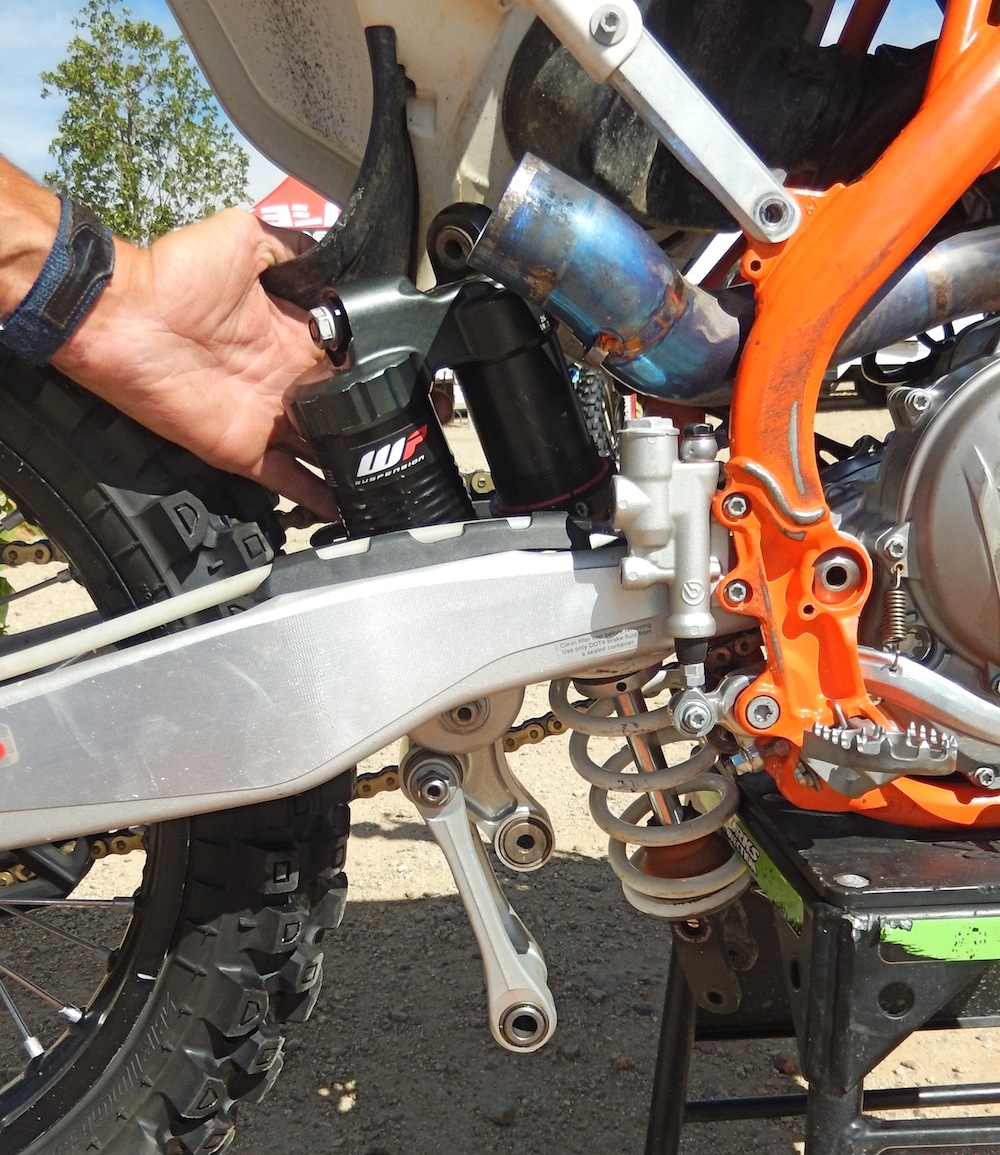
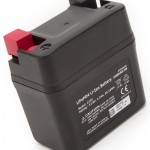
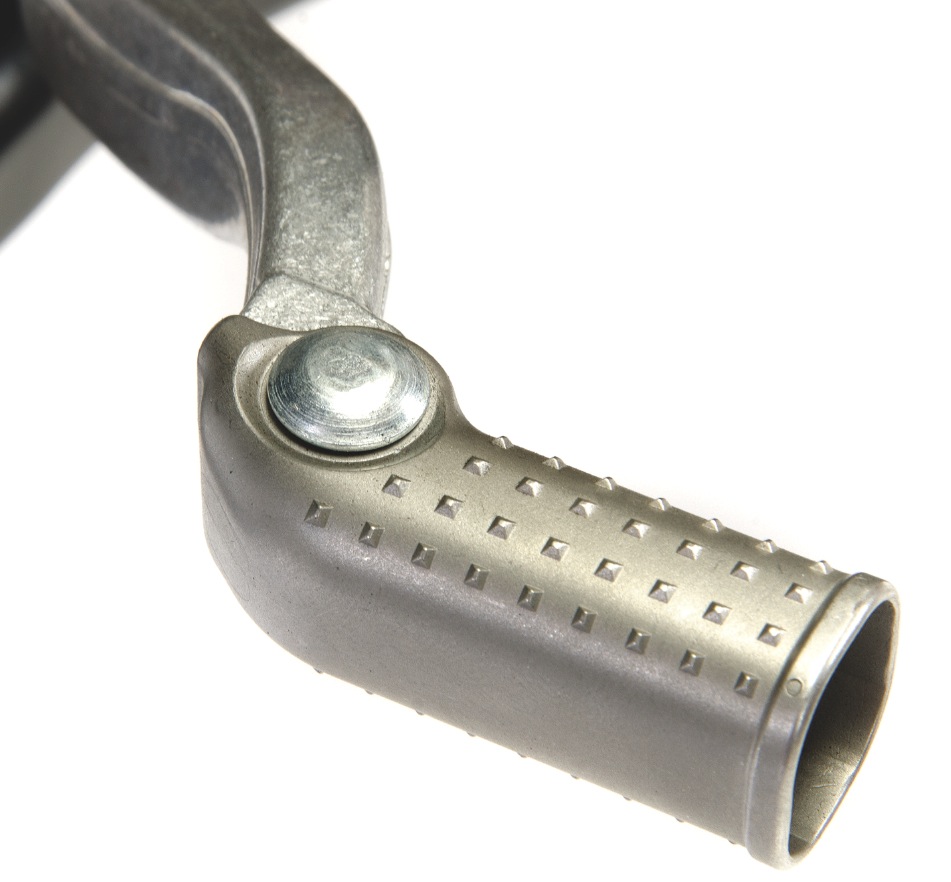




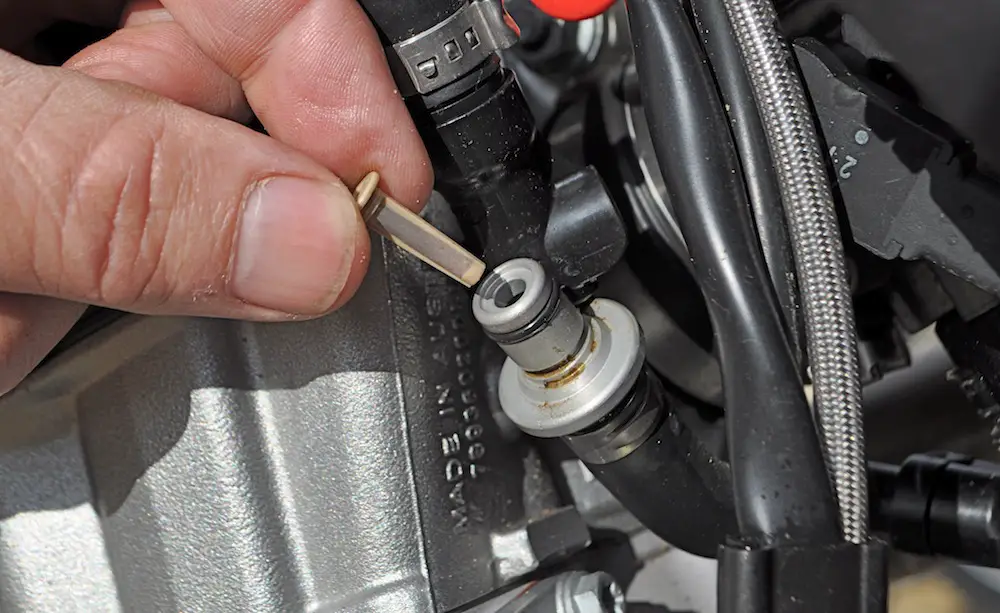

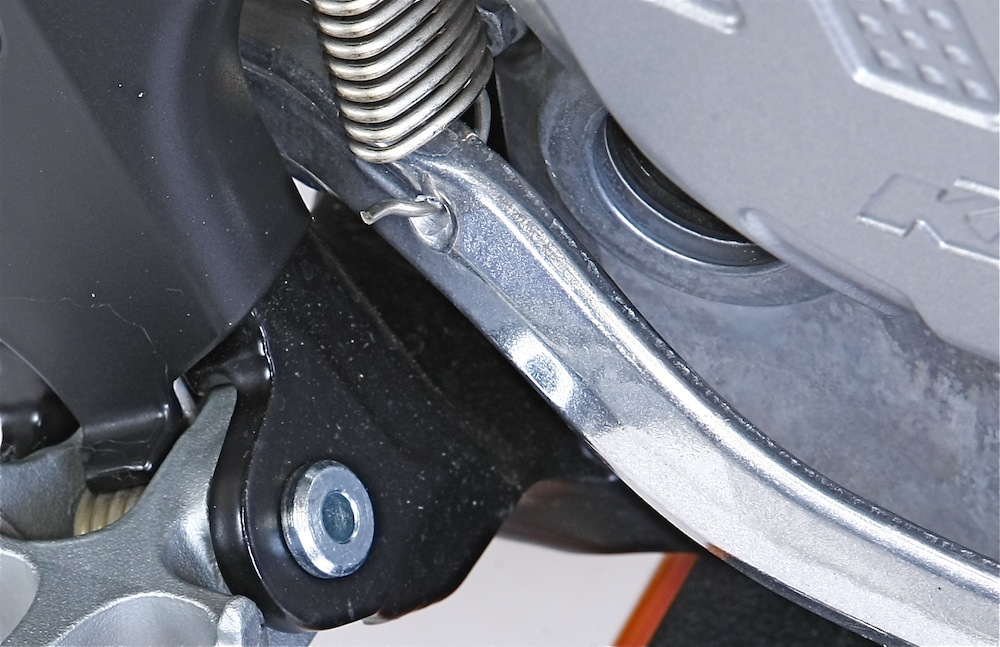
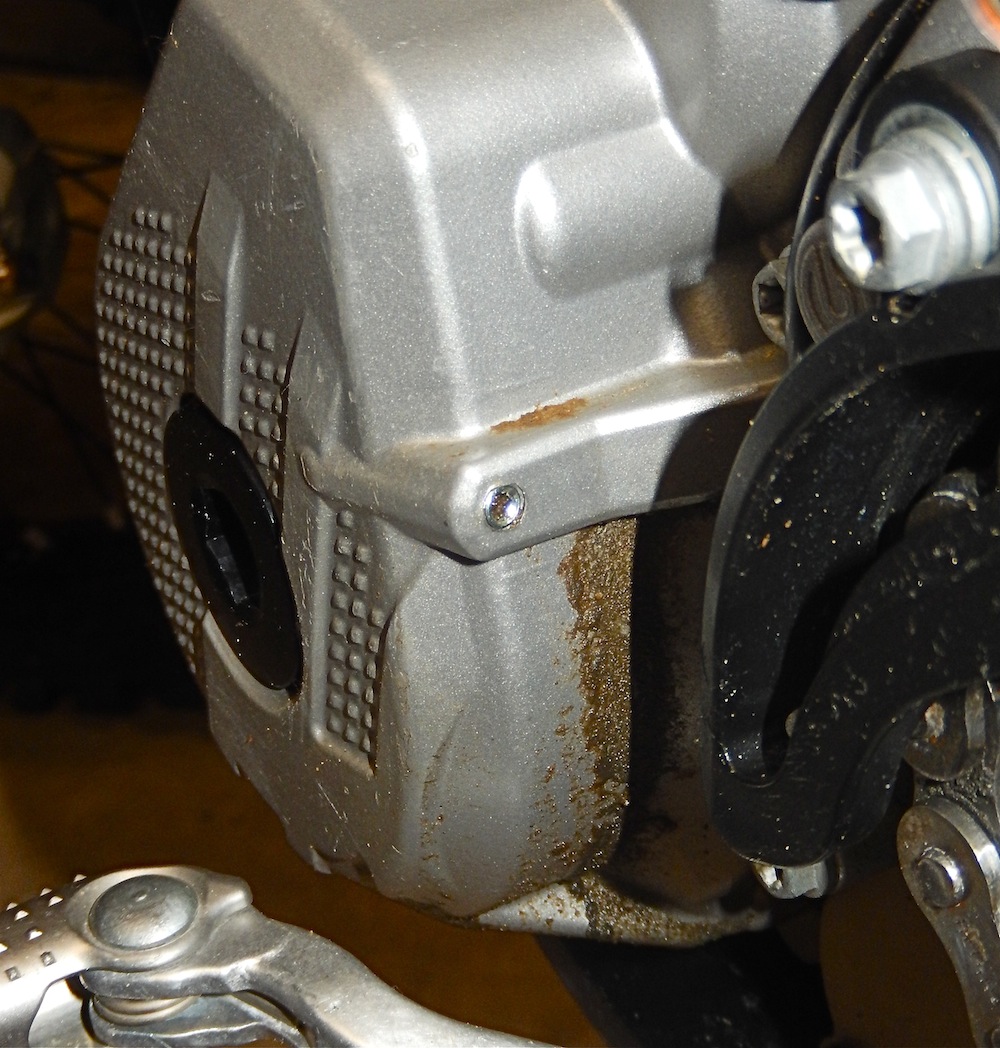
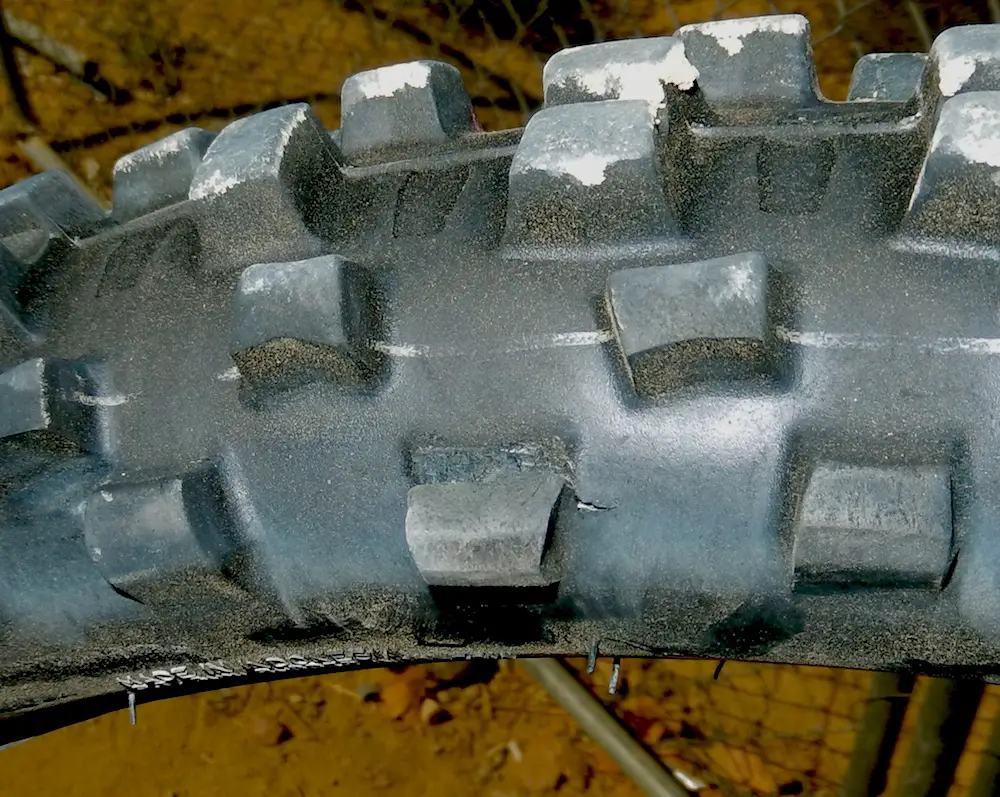
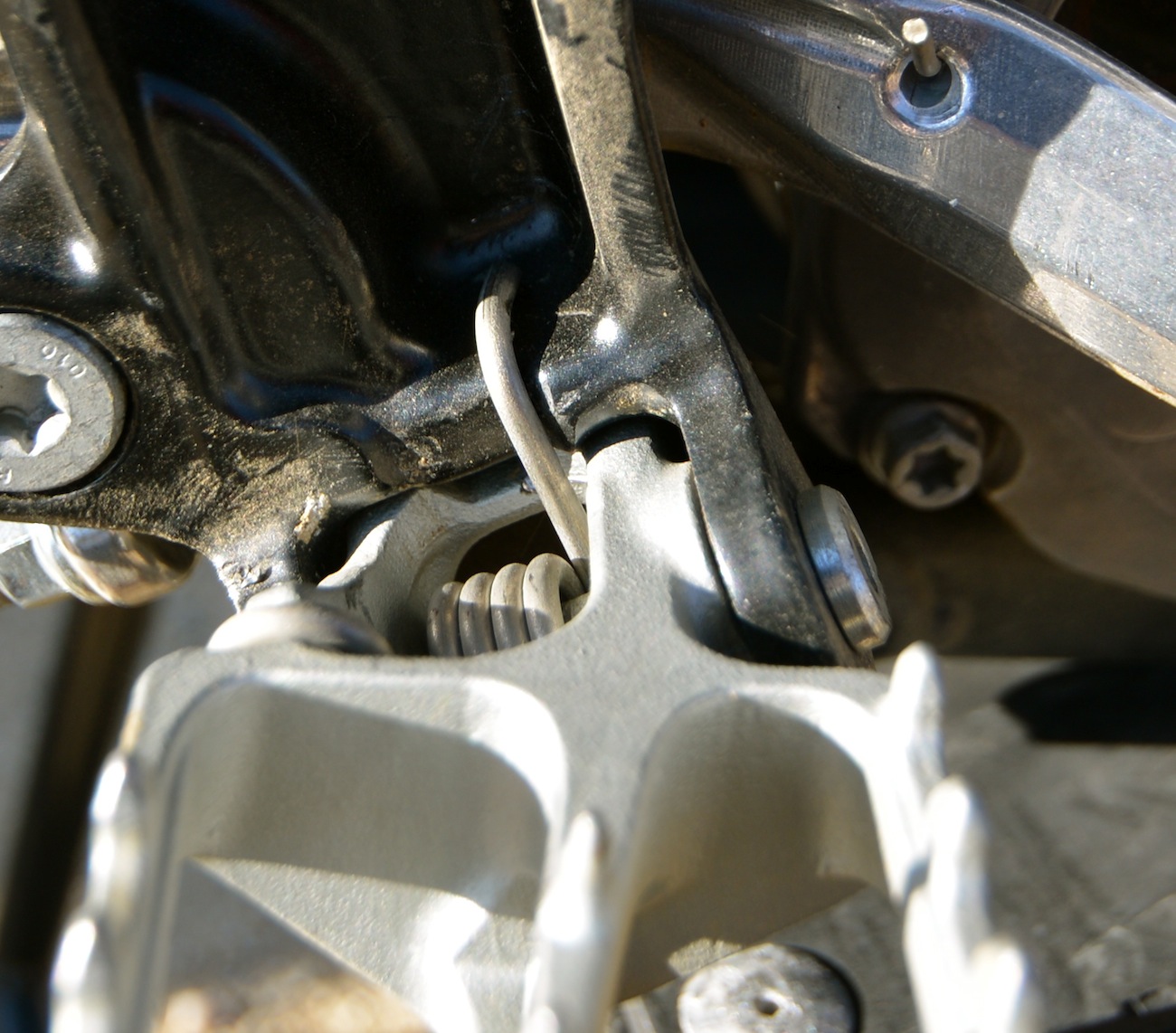
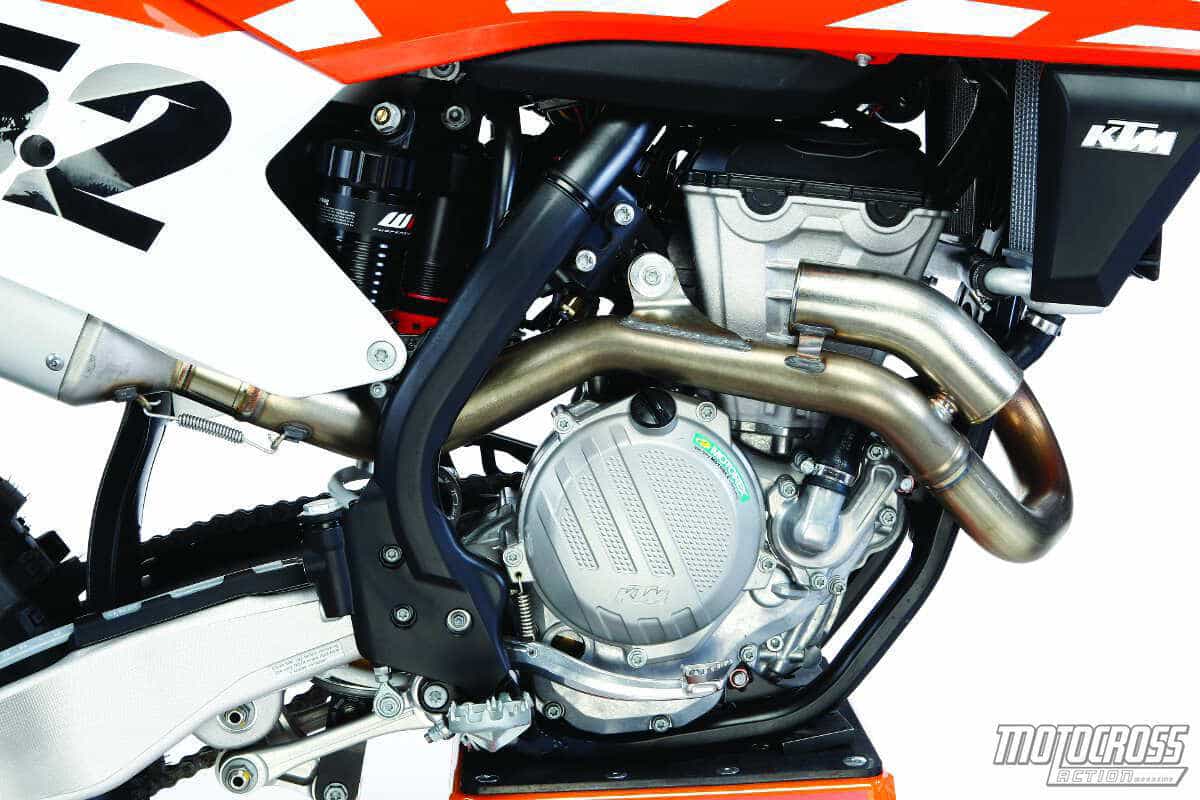

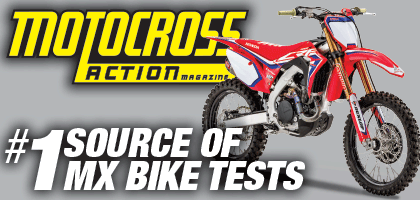


Comments are closed.